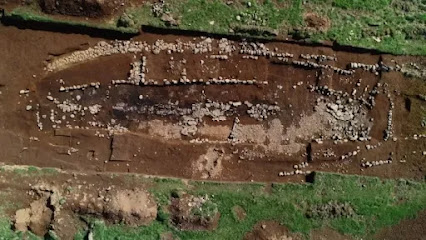Gigantic stone constructions from millennia ago can be found in the deserts of the Middle East. These stone assemblies are referred to as “kites” and are immense hunting traps constructed by piling natural stone into large enclosures with converging lanes of stone wall leading into them. These were used by driving prey animals toward the opening of the converging walls which then guide them into the trap where the hunters can harvest them. I have previously written about this kind of hunting trap on RockArtBlog in 2012 and 2015 (see references at the end of this article).
Now, we
have been informed of the discovery of petroglyphs which very convincingly have
been interpreted as diagrams of two of these “kites.” The name “kite” is
believed to have been bestowed upon the large traps by Royal Air Force pilots
back in the 1920s who first saw them from the air and reported them.
“In new research, Dr. Remy Crassard, an archaeologist at the
Université Lyon and CNRS, and colleagues examined two engravings — dated to
between 7,000 and 8,000 years old — that depict nearby desert kites in
south-eastern Jordan and northern Saudi Arabia.
“In Jordan, the Jibal al-Khasabiyeh area has eight kites,” the researchers said.” (de Lazaro 2023)
“Two large, engraved stones found in the Middle East display the oldest known building plans drawn to scale, researchers say. One carved depiction covers part of a rectangular stone found at a Jordanian campsite dating to about 9,000 years ago. Two other engravings were made roughly 8,000 years ago on a boulder discovered at the base of a cliff in Saudi Arabia. Carvings on these stones depict nearby desert kites, massive structures once used to capture animal herds, scientists report May 17 in PLOS ONE. Desert kites consist of stone walls up to five kilometers long that narrow into large enclosures surrounded by pits where hunters trapped animals, such as gazelles and deer. Kite depictions at the two sites closely resemble the shape, layout and proportions of desert kites found close by, archaeologist Remy Crassard and colleagues say.” (Bower 2023) These petroglyphs do seem to resemble nearby kites which has led to their being touted as ‘blueprints” or ‘construction plans’.
“One engraving depicting a kite is
carved onto a rock roughly 80 centimeters long and 32 centimeters wide.
Archaeologists found it in 2015 in an ancient campsite beside a kite in the
Jordanian desert’s Jibal al-Khashabiyeh region.” (Metcalf 2023)
All of the press coverage on these discoveries seems to assume that they are “blueprints” or “plans” for recreating the hunting traps. While that is a fun idea, I don’t buy it. The scale and/or shapes of the hunting trap will be determined by the local geology and the mental design of its creators, not some picture on a rock. They would have no use for a ‘blueprint’ or ‘plan.’ I am much more sympathetic to the idea that the petroglyphs are celebrations or memorials to the completion of what was obviously a major effort, the construction of the hunting trap. Sort of a “look what we did,” like the bronze plaque in the lobby of a major building. Their resemblance to particular kites nearby seems to me to back up that interpretation. And, given the scale of these kites, the completion of one would have been a reason to celebrate.
NOTE: Some images in this posting were retrieved from the internet with a search for public domain photographs. If any of these images are not intended to be public domain, I apologize, and will happily provide the picture credits if the owner will contact me with them. For further information on these reports you should read the original reports at the sites listed below.
REFERENCES:
Benedict, James, 1985, personal communication.
Bower, Bruce, 2023, The oldest scaled-down drawings of actual structures go back 9,000
years, 17 May 2023, https://www.sciencenews.org.
Accessed online 18 May 2023.
Crassard, Remy et al., 2023, The oldest plans to scale of human made mega-structures, 17 May 2023. https://doi.org/10.1371/journal.pone.0277927. Accessed online 18 May 2023.
De Lazaro, Enrico, 2023, Neolithic Engravings are Oldest Architectural Plans of Human Made Mega-Structures, 18 May 2923, https://www.sci.news/archaeology/desert-kite-plans-11926.html. Accessed online 18 May 2023.
Faris, Peter, 2012, A Bighorn Sheep Trap Petroglyph Near Moab, 9 June 2012, https://rockartblog.blogspot.com.
Faris, Peter, 2015, Stone Blinds and Drivelines – Rollins Pass, CO, 14 February 2015, https://rockartblog.blogspot.com.
Metcalf, Tom, 2023, Stone Engravings of Mysterious Ancient Megastructures May Be The World’s Oldest Blueprints, 17 May 2023, https://www.scientificamerican.com. Accessed online 18 May 2023.











































